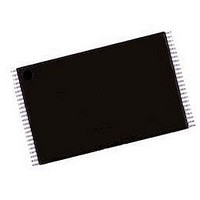AM29LV641DH120REI Spansion Inc., AM29LV641DH120REI Datasheet - Page 33

AM29LV641DH120REI
Manufacturer Part Number
AM29LV641DH120REI
Description
Flash Memory IC
Manufacturer
Spansion Inc.
Specifications of AM29LV641DH120REI
Memory Configuration
4M X 16
Ic Interface Type
Parallel
Access Time
120ns
Memory Case Style
TSOP
No. Of Pins
48
Mounting Type
Surface Mount
Peak Reflow Compatible (260 C)
No
Supply Voltage
3V
Lead Free Status / RoHS Status
Contains lead / RoHS non-compliant
DQ2: Toggle Bit II
The “Toggle Bit II” on DQ2, when used with DQ6, indi-
cates whether a particular sector is actively erasing
(that is, the Embedded Erase algorithm is in progress),
or whether that sector is erase-suspended. Toggle Bit
II is valid after the rising edge of the final WE# pulse in
the command sequence.
DQ2 toggles when the system reads at addresses
within those sectors that were selected for erasure.
(The system may use either OE# or CE# to control the
read cycles.) But DQ2 cannot distinguish whether the
sector is actively erasing or is erase-suspended. DQ6,
by comparison, indicates whether the device is ac-
tively erasing, or is in Erase Suspend, but cannot dis-
tinguish which sectors are selected for erasure. Thus,
both status bits are required for sector and mode infor-
mation. Refer to
puts for DQ2 and DQ6.
Figure 6, on page 30
flowchart form, and the section “DQ2: Toggle Bit II” ex-
plains the algorithm. See also the
on page 30
the toggle bit timing diagram.
shows the differences between DQ2 and DQ6 in
graphical form.
Reading Toggle Bits DQ6/DQ2
Refer to
sion. Whenever the system initially begins reading tog-
gle bit status, it must read DQ7–DQ0 at least twice in a
row to determine whether a toggle bit is toggling. Typi-
cally, the system would note and store the value of the
toggle bit after the first read. After the second read, the
system would compare the new value of the toggle bit
with the first. If the toggle bit is not toggling, the device
has completed the program or erase operation. The
system can read array data on DQ7–DQ0 on the fol-
lowing read cycle.
However, if after the initial two read cycles, the system
determines that the toggle bit is still toggling, the sys-
tem also should note whether the value of DQ5 is high
(see the sub-section on DQ5). If it is, the system
should then determine again whether the toggle bit is
toggling, since the toggle bit may have stopped tog-
gling just as DQ5 went high. If the toggle bit is no
longer toggling, the device has successfully completed
the program or erase operation. If it is still toggling, the
device did not completed the operation successfully,
and the system must write the reset command to re-
turn to reading array data.
The remaining scenario is that the system initially de-
termines that the toggle bit is toggling and DQ5 has
not gone high. The system may continue to monitor
January 22, 2007 22366C6
Figure 6, on page 30
subsection.
Table 11 on page 32
shows the toggle bit algorithm in
Figure 19, on page 43
for the following discus-
Figure 20, on page 43
“DQ6: Toggle Bit I”
to compare out-
Am29LV640D/Am29LV641D
D A T A
shows
S H E E T
the toggle bit and DQ5 through successive read cy-
cles, determining the status as described in the previ-
ous paragraph. Alternatively, it may choose to perform
other system tasks. In this case, the system must start
at the beginning of the algorithm when it returns to de-
termine the status of the operation (top of
page
DQ5: Exceeded Timing Limits
DQ5 indicates whether the program or erase time has
exceeded a specified internal pulse count limit. Under these
conditions DQ5 produces a “1,” indicating that the program
or erase cycle was not successfully completed.
The device may output a “1” on DQ5 if the system tries
to program a “1” to a location that was previously pro-
grammed to “0.” Only an erase operation can
change a “0” back to a “1.” Under this condition, the
device halts the operation, and when the timing limit is
exceeded, DQ5 produces a “1.”
Under both these conditions, the system must write
the reset command to return to the read mode (or to
the erase-suspend-read mode if the device was previ-
ously in the erase-suspend-program mode).
DQ3: Sector Erase Timer
After writing a sector erase command sequence, the
system may read DQ3 to determine whether or not
erasure has begun. (The sector erase timer does not
apply to the chip erase command.) If additional
sectors are selected for erasure, the entire time-out
also applies after each additional sector erase com-
mand. When the time-out period is complete, DQ3
switches from a “0” to a “1.” If the time between addi-
tional sector erase commands from the system can be
assumed to be less than 50 µs, the system need not
monitor DQ3. See also
quence” on page
After the sector erase command is written, the system
should read the status of DQ7 (Data# Polling) or DQ6
(Toggle Bit I) to ensure that the device has accepted
the command sequence, and then read DQ3. If DQ3 is
“1,” the Embedded Erase algorithm has begun; all fur-
ther commands (except Erase Suspend) are ignored
until the erase operation is complete. If DQ3 is “0,” the
device accepts additional sector erase commands. To
ensure the command was accepted, the system soft-
ware should check the status of DQ3 prior to and fol-
lowing each subsequent sector erase command. If
DQ3 is high on the second status check, the last com-
mand might not have been accepted.
Table 11 on page 32
to the other status bits.
30).
26.
shows the status of DQ3 relative
“Sector Erase Command Se-
Figure 6, on
31















